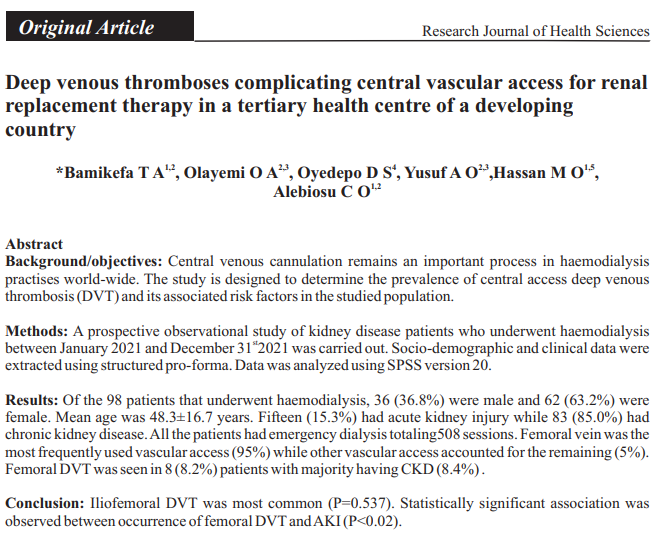Deep venous thromboses complicating central vascular access for renal replacement therapy in a tertiary health centre of a developing country
Keywords:
Deep Venous Thromboses, Central vascular access, Haemodialysis, Chronic kidney diseaseAbstract
Background/objectives: Central venous cannulation remains an important process in haemodialysis practises world-wide. The study is designed to determine the prevalence of central access deep venous thrombosis (DVT) and its associated risk factors in the studied population.
Methods: A prospective observational study of kidney disease patients who underwent haemodialysis between January 2021 and December 31st2021 was carried out. Socio-demographic and clinical data were extracted using structured pro-forma. Data was analyzed using SPSS version 20.
Results: Of the 98 patients that underwent haemodialysis, 36 (36.8%) were male and 62 (63.2%) were female. Mean age was 48.3±16.7 years. Fifteen (15.3%) had acute kidney injury while 83 (85.0%) had chronic kidney disease. All the patients had emergency dialysis totaling508 sessions. Femoral vein was the most frequently used vascular access (95%) while other vascular access accounted for the remaining (5%). Femoral DVT was seen in 8 (8.2%) patients with majority having CKD (8.4%) .
Conclusion: Iliofemoral DVT was most common (P=0.537). Statistically significant association was observed between occurrence of femoral DVT and AKI (P<0.02).
References
Grassmann A, Gioberge S, Moeller S, B G. ESRD patients in 2004: Global overview of patient numbers, treatment modalities and associated trends. Nephrol Dial Transplant (2005); 20:2587-93.
Bamgboye EL, Mabayoje MO, Odutola TA, Mabadeje AF. Acute renal failure at the Lagos university teaching hospital: A 10-year review. RenFail (1993); 15:77-80.
Abene EE, Gimba ZM, Bello RN, Maga AI,
Agaba EI. Practice of hemodialysis in a resourcepoor setting in Nigeria: A 2-year experience. Niger Med J (2017); 58:156-9.
Ekrikpo UE, Udo AI, Ikpeme EE, Effa EE. Haemodialysis in anemerging centre in a developing country: A two-year review andpredictors of mortality. BMC Nephrol (2011); 12:50.
Eghan BA, Amoako-Atta K, Kankam CA,
Nsiah-Asare A. Survivalpattern of hemodialysis patients in Kumasi, Ghana: A summary of fortypatients initiated on hemodialysis at a new hemodialysis unit. HemodialInt (2009); 13:467-71.
Chan KE, Maddux FW, Tolkoff-Rubin N, Karumanchi SA, Thadhani R, Hakim RM. Early outcomes among those initiating chronic dialysis in the United States. Clin J Am Soc Nephrol (2011); 6:2642-9.
Adamu S A, Mohammed A, Usman M T, Yusuf S
M. An audit of the central venous catheterization in the University of Maiduguri Teaching
Hospital, Borno state, Nigeria: Journal of Dental and Medical Sciences (2014);13: 4-7.
Edgeworth J. Intravascular catether infection. J Hosp Infect. (2009); 73 (4): 323-330.
Okunola Y, Ayodele O, Akinwusi P, Gbadegesin B, Oluyombo R. Haemodialysis practice in a resource limited setting in the tropics. Ghana Med J. (2013); 47: 4-9.
Pisoni RL, Young EW, Dykstra DM. Vascular access use in Europe and the United States: Results from the DOPPS. Kidney Int (2022); 61:323-330
Bello BT, Raji YR, Sanusi I, Braimoh RW, Amira OC, et al. Challenges of providingmaintenance hemodialysis in a resource poor country: Experience from a single teaching hospital in Lagos,Southwest Nigeria. Hemodial Int. (2013); 17: 427-433.
Agaba EI, Lopez A, Ma I, Martinez R,
Tzamaloukas RA, Vanderjagt DJ, et al. Chronic hemodialysis in a Nigerian teaching hospital: Practice and costs. Int J Artif Organs (2003); 26:991-5.
13) Ayodele OE, Okunola OO, Akinwusi PO et al. Two-year review of patients with chronic kidney failure undergoing haemodialysis in a new dialysis centre in Nigeria: Any New Lesson? Trop. J. Nephrol (2008) Dec; 3: 103-109.
Shibiru T, Gudina EK, Habte B, Deribew A, Agonafer T. Survival patterns of patients on maintenancehemodialysis for end stage renal disease in Ethiopia: summary of 91 cases. BMC Nephrol (2013); 14:127.
Dada SA, Ajite AB, Ibitoba FA, Thomas AA, Dada OE, et al. Challenges of haemodialysis: A single centre experience in South West Nigeria. J Clini Nephrol. (2019); 3: 055-060.
Joynt GM, Kew J, Gomersal CD, Leung VY, Liu EK. Deep venous thromboses caused by femoral catethers in critically ill adult patients. Chest. (2000) Jan; 117(1): 178-83.
Durbec O, Viviand X, Potie F, Vialet R, Albanese J, Martin C. A prospective evaluation of the use of femoral venous catethers in critically ill adults. Crit Care Med. (1997) Dec; 25 (12):19869.
Margaret M T, Dimas A P. Incidence and
Characteristics of DoubleLumen Induced
C e n t r a l Ve n o u s C a t h e t e r- R e l a t e d
Thromboembolism In Hemodialytic Patients Medicinus. (2020) October; 8(3): 111-116.
Steiger E. Dysfunctioin and thrombotic complications of vascular access devices. JPEN. (2006); 30:1.
Rooden C, Tesselaar M, Osanto, S., Rosendaal, F. Huisman, M. Deep vein thrombosis associated with central venous catheters - a review. Journal of Thrombosis and Haemostasis. (2005); 3:2409-2419.

Downloads
Published
How to Cite
Issue
Section
License
Copyright (c) 2023 Research Journal of Health Sciences

This work is licensed under a Creative Commons Attribution-NonCommercial-NoDerivatives 4.0 International License.
Research Journal of Health Sciences journal is a peer reviewed, Open Access journal. The Journal subscribed to terms and conditions of Open Access publication. Articles are distributed under the terms of Creative Commons License (CC BY-NC-ND 4.0). (http://creativecommons.org/licences/by-nc-nd/4.0). All articles are made freely accessible for everyone to read, download, copy and distribute as long as appropriate credit is given and the new creations are licensed under the identical terms.

